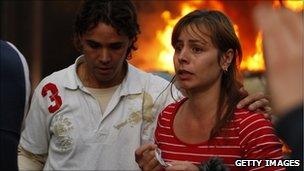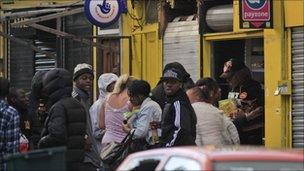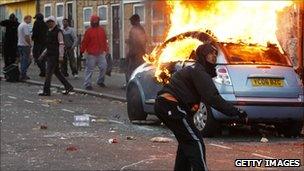Trouble in the heart of Hackney
- Published

Police moved in to try to guard the businesses that had been looted
The BBC's Alix Kroeger conveys the violence of the protests in Hackney, and the police response to the unrest as it developed on Monday afternoon.
To find the centre of the disturbances in Hackney, all I had to do was head towards the police helicopters hovering overhead.
A line of buses had been parked, to all intents and purposes abandoned, at the top of Mare Street, the main road through the area.
Under the railway bridge, riot police formed a line, the lights on their vans flashing behind them. I could see the shopping precinct beyond, where the trouble had begun, but could not get through.
On Mare St, clumps of rioters surged forward and then retreated as police ran towards them.
A group of young men began trying to tear the metal shutter off a jewellery shop. All the shops in the area were closed.

Concerned residents tried to escape
One woman walking her dog argued with police; all she wanted was to get home, but her home lay on the other side of the riot and the police would not let her through.
Most of those directly confronting the police were young; many had masked their faces with balaclavas or bandannas.
Some began rocking a bin from side to side, pulling it loose from the pavement.
They broke into a branch of JD Sports.
One looter walked right in front of me, his arms full of grey and red sweatpants still on their hangers.
'Olympic borough'
The police began to push the rioters back, down Mare St to the south.
I took cover in a side street, but I was not the only one: some of the rioters, and a fair few onlookers, had the same idea.
Riot police followed us, blocking off the way back to the main road: some had dogs which lunged forward on their leashes, snarling.
At one point, the police charged up the lane. I took cover in a doorway as dozens of people ran past. After a lot of anger and shouting, it was safe to come out again and keep moving.

Several shops were looted
By this time, most of the crowd were around Hackney Town Hall and the Hackney Empire theatre. One of the great 19th Century music halls, it was recently refurbished - a much-needed investment in a borough where poverty and unemployment are widespread.
But for many people living around here, it is not enough to make a difference.
This is the Olympic borough, one man told me, but the money and the opportunities are not getting through.
He and a friend condemned the looting and the rioting: they said it was local residents and businesses that would pay the price for the unrest.
Social problems
By no means had everyone who was there taken part in the violence.
I spoke to one woman who was desperately worried for her 17-year-old son, afraid he would go along with his friends and end up in trouble.
Afro-Caribbean youths like him were being stopped and searched by the police twice or three times a day, she said.
A youth worker herself in south London, where there has also been unrest, she said despairingly: "We knew this was going to happen. We told them."
She said funding for services had been cut, leaving young people with nowhere to go but the street.
By this time, an acrid pall of grey smoke from a burning car hung over Mare St.
A bottle bank had been tipped over, spilling hundreds of bottles on to the street, some of them used as makeshift missiles by the rioters, who also shot firecrackers directly at the police.

Rioters were said to be coordinating by BlackBerry
A burglar alarm shrilled from a jeweller's shop which had been attacked. A pair of silver cufflinks, still in their plastic box, lay in the gutter.
By this point, the rioters were beginning to disperse. The police, too, began to move off, their vans making a crunching sound from all the broken glass beneath their wheels.
In a side street, another car was ablaze, guarded by half a dozen riot officers. I spoke to two youths who were watching it burn.
One had received an update on his BlackBerry Messenger - the social network used by many of the rioters to co-ordinate their movements - which, he said, gave a list of areas where further disturbances were being planned.
Back at the top of Mare St, the glaziers were already at work, boarding up shattered windows. Police were guarding the businesses that had been looted.
There was more smoke from behind the shopping precinct where the trouble originated. A police officer told me more vehicles were on fire.
As I turned to leave, I was passed by a group of youths on bicycles, all of them masked, laughing and pedalling furiously westward.
The disturbances in Hackney might have subsided, but across London, there was clearly more trouble in store.
- Published9 August 2011